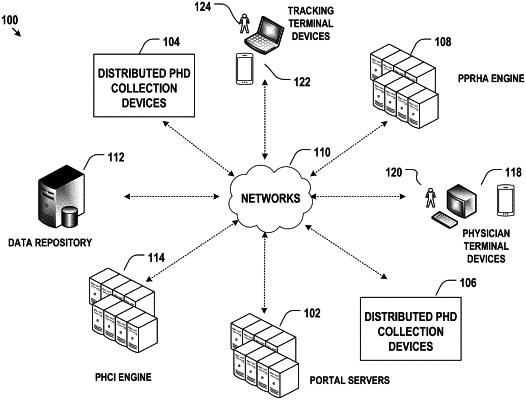| CPC A61B 5/1075 (2013.01) [A61B 5/0064 (2013.01); A61B 5/1071 (2013.01); A61B 5/1114 (2013.01); A61B 5/1116 (2013.01); A61B 5/4538 (2013.01); A61B 5/486 (2013.01); A61B 5/7475 (2013.01); G06V 10/42 (2022.01); G06V 20/64 (2022.01); G06V 40/103 (2022.01); G16H 10/60 (2018.01); G16H 30/40 (2018.01); G16H 50/30 (2018.01); A61B 5/7267 (2013.01); A61B 5/7435 (2013.01)] | 20 Claims |

|
1. A system, comprising:
a repository for storing a plurality of independent algorithms each configured for deterministically identifying a level of a predetermined health condition of a patient based on a set of geometric rules of landmarks within a 3D topographical body scan of the patient, wherein the set of geometric rules are associated with a set of trainable geometric thresholds for each of the plurality of independent algorithms; and
a processing circuitry in communication with the repository configured to;
receive the 3D topographical body scan;
extract a set of landmarks from the 3D topographical body scan;
generate a plurality of visual representations each associated with the set of geometric rules of one of the plurality of independent algorithms;
provide a display interface to display each of the plurality of visual representations overlaid with the 3D topographical body scan, wherein the 3D topographical body scan along with each of the plurality of visual representations is freely orientable by a user of the display interface;
obtain a user feedback comprising at least a level label of the predetermined health condition associated with the 3D topographical body scan;
add the user feedback to a training dataset, wherein each data item of the training dataset comprises a user-feedback-algorithm-3D body scan association;
obtain the set of trainable geometric thresholds for each of the plurality of independent algorithms using a machine learning model based on the training dataset; and
predict an estimated level of the predetermined health condition associated with a new 3D topographical body scan using a predetermined consensus procedure for aggregating predictions from the plurality of independent algorithms.
|